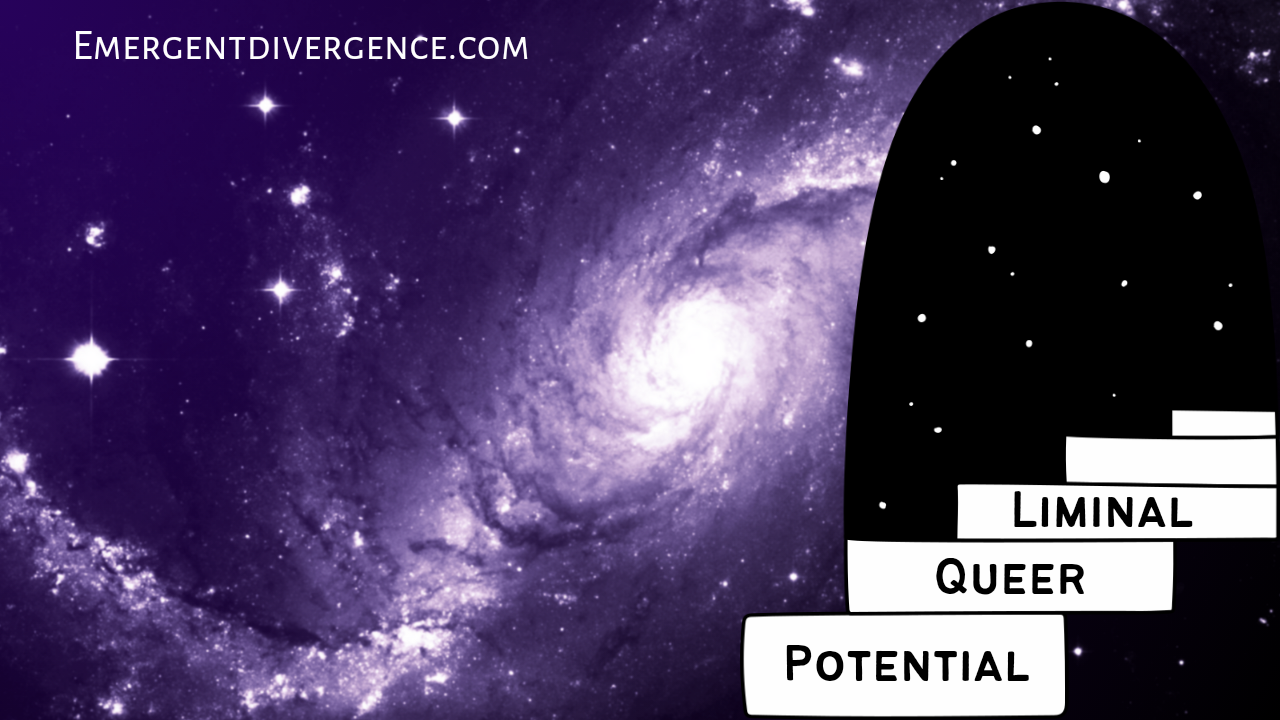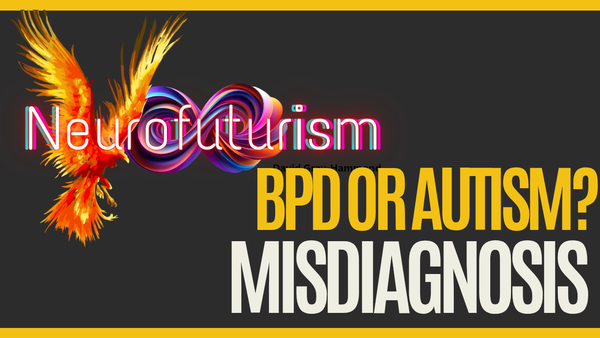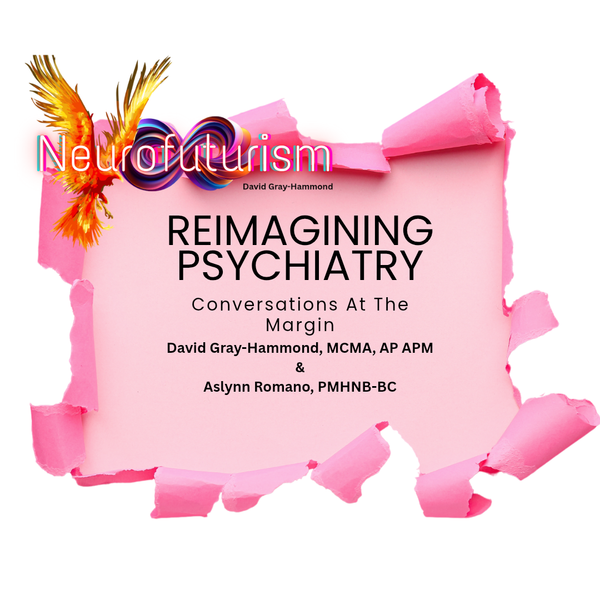Reclaiming Neurofuturism: The Liminal as a space of Queer potential

Further to my response to Edgar (2024a) addressing the litigious nature of neurodivergent embodiment (Gray-Hammond, 2024), is Edgar's response considering the neuroqueering potential to be found in liminal spaces. Liminal spaces are the point where on thing becomes another. A doorway between rooms is a liminal space. Liminal spaces also occur between communities and rhizomes (Gray-Hammond, 2023). One can be forgiven for thinking these "in-between" spaces are places we are stuck when in truth they are spaces of potential. The space between rhizomes is a place of becoming, of forming connections that previously did not exist. As such, Autistic people, who are famously found in spaces between communities are in a unique position to create new structures.
The liminal as a space of becoming
"As an autistic person, I feel I have lived my entire life in the liminal. I have always been in-between or on the edges of social groups, always struggling with an internal battle due to the effects masking has on my sensory system. Being monotropic has meant the in-between is felt intensely; it has led to cycles of burnout and impacts my mental, physical and sensory health"
Edgar (2024b)
"In-between" spaces have been viewed for much time as a place of stagnation. I would argue however that they provide a space free of constraint. Such space allows us to "become" something, to change who we are, to imagine a new bodymind. Inclusivity requires us to step outside of our world and move through liminal space to anothers world. Edgar (2024b) mentions radical inclusivity as a tool of connection:
"Radical inclusivity is more than accommodating needs; it is about fostering cognitive and somatic liberty to enable the potential of neuroqueering to open up new, as yet unknown possibilities."
Edgar (2024b)
Such radical inclusivity also requires radical acceptance. Acceptance of our potential to become the connection, our potential to exist within liminal space as a bridge between rhizomes. The liminal space, then, is not a place of stagnation, but one of growth and evolution. It is the site of plasticity in the world's communities. All communities exist within liminal spaces, much as planets exist in empty space. A community was once a nothing that became a something, liminality provided the potential to become.
Queer potential
"We need connections, a shared deep understanding, an embodied presence, a sense of meaning, and a sense of belonging. We need community, love and kindness to expand the rhizome."
Edgar (2024b)
Given the individualistic nature of our current world, connection itself can be viewed as a Queer endeavour. By connecting with one another and resisting the siloing (Gray-Hammond, 2024) of our communities we are queering communities. Liminality creates space that is free from the identity politics (and national politics) that make such connection difficult.
Further to this is the liberatory potential of queer space. The liminal is a space free of what Walker (2021) identifies as the masters house.
A paradigm is not just an idea or a method. A paradigm is a set of fundamental assumptions or principles, a mindset or frame of reference that shapes how one thinks about and talks about a given subject. A paradigm shapes the ways in which one interprets information, and determines what sort of questions one asks and how one asks them. A paradigm is a lens through which one views reality.
Walker (2021)
The masters house represents a dominant paradigm. In the context of neuroqueer theory, this would be the pathology paradigm. A paradigm within which deviation from normative embodiment is seen as disordered. The liminal represents a space outside of paradigm. It is a pinnacle of queer space in that it's potential is one of unbounded queening; in the liminal, the very meaning of being human may be called into question. Perhaps it would be more accurate to say that in the liminal we can create a new meaning for humanity.
Queer liminality and the connection of rhizomes
"Strike the pose or follow the axis, genetic stage or structural destiny—one way or the other, your rhizome will be broken. You will be allowed to live and speak, but only after every outlet has been obstructed. Once a rhizome has been obstructed, arborified, it's all over, no desire stirs; for it is always by rhizome that desire moves and produces."
Deleuze & Guattari (2013)
The queer liminal space allows for connection and expansion because there is no axis to follow. There is no map to trace. The pathology paradigm seeks to arborify rhizomes, reducing them to roots and radicles. In liminal space, lack of structure allows for the organic development and joining up of rhizomes. It is in the liminal where minority silos come together. To the masters house, it is an existential threat. To the oppressed minority, it is a place where what we were taught to be impossible becomes not only possible but probable. With infinite liminal space and infinite time, queer improbability becomes queer realisation. That which we are told can not happen is subverted into existence.
Queer potential in the context of neurodiversity
There is a level of essentialism, even within the neurodiversity movement. People are positioned in a binary polarity of neurotypical or neurodivergent. In truth, in eight billion people reside eight billion types of brains. Human minds are not finite. With each new human comes a bodymind not yet seen. Further more, those bodyminds can be queered. When we step into liminal space, we escape the pull of normative hegemony that wishes us to believe we are all we can be, that there is nothing more to discover.
Queer space is a space of somatic and cognitive discovery, made possible by the space between. It is through that discovery that we make connection with others possible. Queer space is the liberation of human kind.
References
Deleuze, G., & Guattari, F. (2013). A Thousand Plateaus. Bloomsbury Academic.
Edgar, H. (2024a). The Double Empathy Problem is DEEP. MoreRealms. Medium. https://medium.com/@helenrealms/the-double-empathy-problem-is-deep-2364b3412c39
Edgar, H. (2024b). Neuroqueering in liminal spaces. MoreRealms. Medium. https://medium.com/@helenrealms/neuroqueering-in-the-liminal-spaces-f7c22c812748
Gray-Hammond, D. (2023). Reclaiming Neurofuturism: Rhizomatic Communities and the Chaotic Self. Emergent Divergence. https://emergentdivergence.com/2023/04/30/reclaiming-neurofuturism-rhizomatic-communities-and-the-chaotic-self/
Gray-Hammond, D. (2024). Reclaiming Neurofuturism: Responding to “The Double Empathy Problem is DEEP” by Edgar, 2024. Emergent Divergence. https://emergentdivergence.com/2024/06/16/reclaiming-neurofuturism-responding-to-the-double-empathy-problem-is-deep-by-edgar-2024/
Walker, N. (2021). Neuroqueer Heresies: Notes on the Neurodiversity Paradigm, Autistic Empowerment, and Postnormal Possibilities. Autonomous Press.


